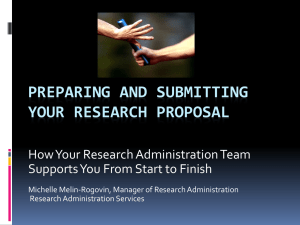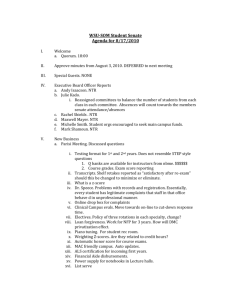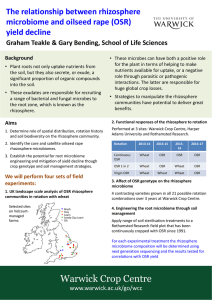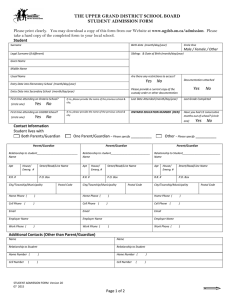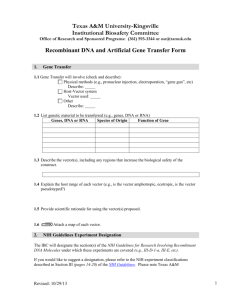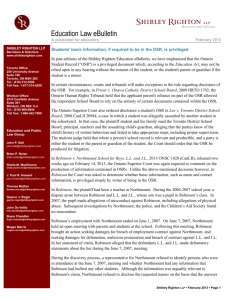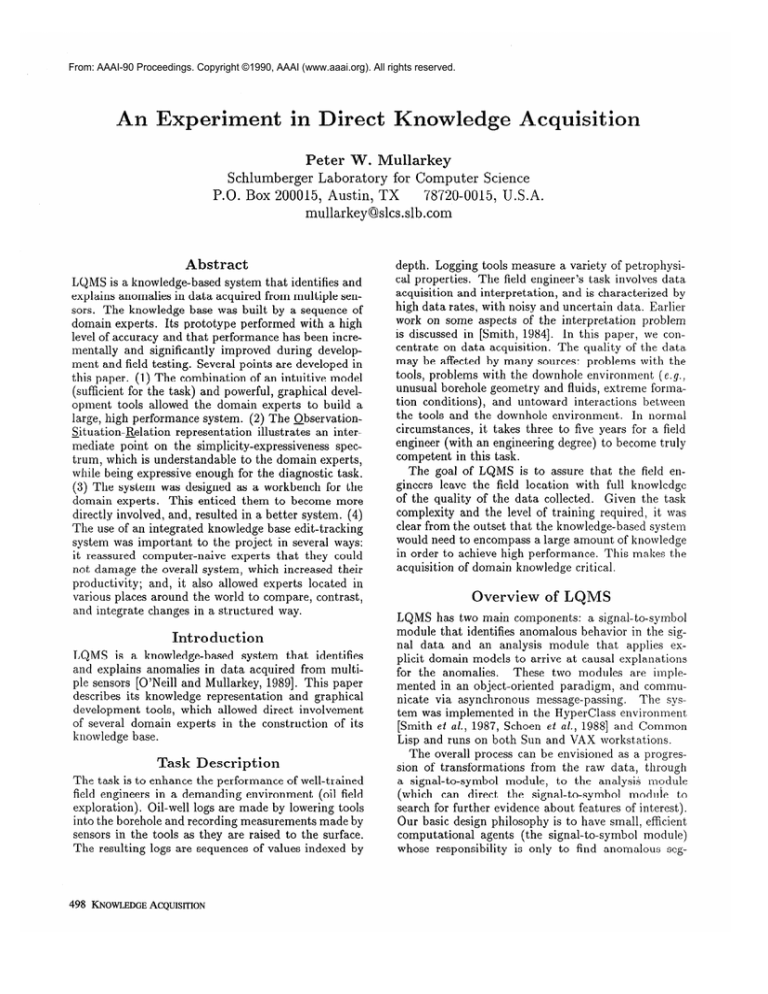
From: AAAI-90 Proceedings. Copyright ©1990, AAAI (www.aaai.org). All rights reserved.
An Experiment
in Direct
Knowledge
Acquisition
Peter W. Mullarkey
Schlumberger Laboratory for Computer Science
P.O. Box 200015, Austin, TX
78720-0015, U.S.A.
mullarkey@slcs.slb.com
Abstract
LQMS is a knowledge-based
system that identifies and
explains anomalies in data acquired from multiple sensors. The knowledge base was built by a sequence of
domain experts.
Its prototype performed with a high
level of accuracy and that performance has been incrementally and significantly
improved during development and field testing. Several points are developed in
this pa.per. (1) The combination
of an intuitive model
(sufficient for the task) and powerful, graphical development tools allowed the domain experts to build a
large, high performance
system. (2) The ObservationSituation-Blation
representation
illustrates
an intermediate point on the simplicity-expressiveness
spectrum, which is understandable
to the domain experts,
while being expressive enough for the diagnostic task.
(3) The system was designed as a workbench for the
domain experts.
This enticed them to become more
directly involved, and, resulted in a better system. (4)
The use of an integrated knowledge base edit-tracking
system was important
to the project in several ways:
it reassured computer-naive
experts that they could
not damage the overall system, which increased their
productivity;
and, it also allowed experts located in
va.rious places around the world to compare, contrast,
and integrate changes in a structured way.
Introduction
L&MS is a knowledge-based
system that identifies
and explains anomalies in data acquired from multiple sensors [O’Neill and Mullarkey, 19891. This paper
describes its knowledge representation
and graphical
development
tools, which allowed direct involvement
of several domain experts in the construction
of its
knowledge base.
Task Description
The task is to enhance the performance of well-trained
field engineers in a demanding environment
(oil field
exploration).
Oil-well logs are made by lowering tools
into the borehole and recording measurements
made by
sensors in the tools as they are raised to the surface.
The resulting logs are sequences of values indexed by
498 KNOWLEDGEACQUISITION
depth. Logging tools measure a variety of petrophysical properties.
The field engineer’s task involves data
acquisition and interpretation,
and is characterized
by
high data rates, with noisy and uncertain data. Earlier
work on some aspects of the interpretation
problem
is discussed in [Smith, 19841. In this paper, we concentrate on data acquisition.
The quality of the data.
may be affected by many sources: problems with the
tools, problems with the downhole environment
(e.g.,
unusual borehole geometry and fluids, extreme formation conditions),
and untoward interactions
between
the tools and the downhole environment.
In normal
circumstances,
it takes three to five years for a field
engineer (with an engineering degree) to become truly
competent in this task.
The goal of LQMS is to assure that the field engineers leave the field location with full knowledge
of the quality of the data collected.
Given the task
complexity
and the level of training required, it was
clear from the outset that the knowledge-based
system
would need to encompass a large a.mount of knowledge
in order to achieve high performance.
This makes the
acquisition of domain knowledge critical.
Overview
of LQMS
LQMS has two main components:
a signal-to-symbol
module that identifies anomalous behavior in the signal data and an analysis module that applies explicit domain models to arrive at causal explanations
for the anomalies.
These two modules are implemented in an object-oriented
paradigm,
and communicate via asynchronous
message-passing.
The system was implemented
in the HyperClass environment.
[Smith et al., 1987, Schoen et al., 19881 and Common
Lisp and runs on both Sun and VAX workst,a.tions.
The overall process can be envisioned as a progression of transformations
from the raw data, through
a signal-to-symbol
module,
to the analysis module
Illoduieto
(which can direct the signal-to-symbol
search for further evidence about features of interest).
Our basic design philosophy is to have small, efficient
computational
agents (the signal-to-symbol
module)
whose responsibility
is only to find anoma.lous seg-
ments of data, and then use more extensive domain
knowledge in the analysis module to discern which
anomalies are problems requiring action, and which are
explainable in other ways. This decomposition
allows
the signal-to-symbol
module to run real-time, while the
analysis module works in background.
A research prototype was deployed over a two-year
field test program in several locations (Houston, TX;
New Orleans, LA; Cairo, Egypt; Midland, TX; and,
Paris, France).
It has done an effective job of dealing
with the task and providing a model that the users feel
is intuitive.
Knowledge
Representation
Model
The analysis module consists of an inference engine
that operates on domain knowledge represented as networks.
These networks are composed of Situations
that can be used to explain groups of jZbservations
connected by Relations;
they are referred to as OSR
networks.
We will explain via the example shown in
Figure 1.
In the example network, Situations are boxed nodes
(e.g.,
LDT-PROBLEM),
Observations
are unboxed
leaf nodes (e.g., RHOB-UNUSUALLY-LOW).
Relations are unboxed
interior nodes, drawn from the
NOT,
( a weighted average),
set AND, OR, COMB
and ANY (essentially
an OR that uses breadth-first
search).
The example network can be understood
(and constructed) from either of two viewpoints.
1. From a symptomatic
view, the network has possible
explanations for the anomaly RHOB-UNUSUALLYLOW (highlighted in the middle right section of the
network). This observation means that the sensor is
measuring a bulk density of the surrounding
material that is lower than normally exp.ected, but not so
low as to be out of the physical measurement
range
of the sensor.
This anomaly can be explained by
a misapplication
of the sensor pad to the surrounding rock (LDT-PAD-STANDOFF),
allowing lowerdensity material (e.g., drilling fluid) to exist between
the sensor and the material of interest,
and/or a
problem with the tool that houses the sensor (LDTPROBLEM).
2. From a “failure model” point of view, there are
two subnetworks
shown in Figure 1. One describes
the observations
that would be associated
with an
LDT sensor pad being out of contact with the borehole wall. The other describes the observations that
would be associated with an LDT tool problem.
The various domain experts have found that a choice
of different ways of visualizing (and building) the networks allows them to think about their knowledge in
the way that is most natural for them.
One domain
expert prefers the symptomatic
perspective,
while another prefers the failure model view, and a third seems
to be comfortable
switching between these views.
The basic components of the knowledge representation scheme were derived by direct observation of the
domain experts at work. This recognition that the behavior of the experts is a real expression of the knowledge is discussed in [Musen, 19891 in regard to separating the knowledge level from the symbol level. The
domain experts visually recognize an anomalous data
pattern, and attempt to construct
a set of conditions
that could explain that anomaly. Their “heuristic associations” between anomalies and multiple possible explanations are not through explicit relations, but such
relations are implicit in the context.
For example, to
support an LDT-PAD-STANDOFF
there needs to be
evidence of both borehole wall roughness (described by
the upper subnetwork to the right of the AND in Figure 1) AND an indication of abnormal density borehole
fluid (described by the lower subnetwork to the right
of the AND in Figure 1). In describing this situation,
the AND relation would be obvious to a domain expert
from the context.
The OSR environment
encourages
the domain expert to make these implicit relations explicit, both for obvious computability
and to make the
networks less ambiguous for the next domain expert.
The OSR framework was developed to organize and
unify the various concepts that seemed intuitive to the
domain experts. These experts clearly had more than a
jumble of loosely-connected
heuristics, but did not use
a complete structural and behavioral model. Our early
experience with a rule-based prototype demonstrated
that the domain experts had difficulty encoding their
knowledge as rules.
Furthermore,
the prototype
did
not clearly support the domain experts’ model. This
was also noted in [Davis and Ha,mscher, 19881.
We were also led to believe tha.t a “deep model”
approach was also not appropriate because:
e No complete model exists for the domain. The lack
of a strong domain model is a good reason for using
a different approach [Hamscher, 1988, page 191.
e The problem solving must be done in a real-time
environment
and “deep models” are typically computationally
intensive.
e The users do not reason with a deep model; hence,
a system using such a model would be less understandable to them.
The inherent simplicity of the OSR framework
is a
strong asset, since (after three years of successful use)
it appears to be expressive enough to cover the domain
of interest, while being intuitively comfortable
to a set
of five geographically
distributed
domain experts with
different backgrounds.
Thus, it illustrates an intermediate point on the simplicity-expressiveness
spectrum.
Inference
LQMS uses its knowledge base of OSR networks in a
way similar to the “cover and differentiate”
problemsolving method used in MOLE [Eshelman,
19881. The
The
signal-to-symbol
module notices an anomaly.
MULLARKEY 499
AddSituation
AddObservation
AddlncompleteNets
CreateRelation
:
CreateLink
ModifyLinkWeight
,, CALI-HIGH-SLOPE
OR(,
ReplaceRelation
DeleteLink
“‘/=t-COMB
6;:’
DeleteRelation
---_-----------
;;;;[LS;o;MALHIGH
“.oR<:‘%
HideRight
HideLeft
DCAL-UNUSUALLY-HIGH
I
,.
HideNode
i
ExpandRight
:
;oFK:*
!’
:
ExpandLeft
Move Node
l
,,OR c’
LDT-PAD-STANDOFF
OLS-MINUS-QSS-UNUSUALLY-HIGH
. QLS-MINUS-QSS-UNUSUALLY-LOW
~-ANN
DRHO-HIGH-VARIANCE
\
Refresh
_----__-__--____
\
COMB.
ShowAll
- - - LOW-MUD-DENSITY
\
NewNetwork
Start ParmEditor
\
‘ORi;;\ ‘\
Describe
8 ‘\
’
‘\
:.
‘. .
‘\\,
‘,
#(+iiE-k
COMB.
- - - HIGH-MUD-DENSIT)
‘\ COM&
I’
‘;
DRHO-UNUSUALLY-LOW
:
COMB I’
*. DRHOLAFiGE-STEi
; PEF-LARGF-STEP
.,
COMB l
‘i
I
1
F&F-uNu$uALLy-HIGH
:
I
-.OR<:(
.- <EF-UNUSUALLY-LOW
LDT-PROBLEM
/--ANY
DRHO-TOO-LOW
;
\ DRHO-TOO-HIGH
i
\
:
I
I
I
I
I
I
I, !SSHV-H/GH-VARIANCE
/OR<::
\
COMB
,:’
.
:
:’
‘.jLSHV-HIGH-VARIANCE
‘.COMB; _. .OR:---
Figure
1: The OSR
Network
analysis module retrieves all situations
that can exIt gathers appropriate
evidence
plain the anomaly.
for discrimination
between the possible explanations
It develops the best
by traversing
the networks.
explanation(s)
for the anomaly from the situations
that have the highest belief, based on available evLQMS combines evidence in the OSR netidence.
works using an algebra that combines beliefs for the
relation types in a conventional manner [Reboh, 1981,
Beliefs
are repreBuchanan and Shortliffe, 19841.
sented as a five-valued range with an explicit representation for unknown values. The particular combination rule used is determined
by the Relation type.
A small set of relations has been found to work well in
the LQMS domain.
LQMS
can show its reasoning
500 KNOWLEDGEACQUISITION
with an animated
dis-
Editor
RHOB-UNUSUALLY-HIGH
(see text for legend)
play of the OSR networks it is processing (highlighting
nodes currently being processed, and changing fonts to
indicate current belief).
The user can also direct the
system to explain its conclusions a.fter a session using a
mouse-sensitive
debriefing report to access the appropriate OSR networks and signal-to-symbol
agents. The
system’s explanation
of its results is clear and meaningful to our domain experts.
Over the three years of
construction,
refinement and use, the main debugging
tool used has been animated OSR networks.
In addition to the basic framework, the OSR environment offers the domain expert several ways of augmenting the networks with further experiential knowledge.
e search
partial
first
order
- The domain expert can specify a
of situations
that are most likely to
explain a particular anomaly.
o relative
link
weights - The links between a relation and its operands can be assigned different
weights, thus their evidence will be combined based
on the specified relative importance.
e tie breaking
- The domain expert can designate
that some situations
be preferred.
Then if a “pre- .
ferred” situation is among the equally believed explanations for an anomaly, it is selected as the best
explanation.
Knowledge-Acquisition
Tools
LQMS has a rich knowledge engineering environment
(based on the HyperClass
system).
These tools have
made it possible for domain experts to enter, test, and
refine the OSR network knowledge base (which contains 1880 classes) with minimal assistance from the
system developers.
Like the knowledge editors in ROGET [Bennett,
19851 and MOLE [Eshelman,
19881, the
OSR Network Editor takes advantage of knowledge of
the problem-solving
method used in LQMS to assist
the user in entering knowledge.
This approach has
been referred to as using a method-orierzted conceptual
model to support knowledge acquisition [Musen, 19891.
The “boxes and links” OSR Network Editor (Figure 1) is the main tool for constructing,
maintaining, and refining OSR networks. It has an integrated,
object-oriented,
edit-tracking
system to notice, save
(and restore) incremental
changes to the knowledge
base.
This allows multiple domain experts to work
independently
on the knowledge base, making increment a.1 changes. It supports review, comparison,
and
conflict detection of various changes proposed for the
core knowledge base. Aside from indicating when they
start and end editing sessions, the domain experts do
not notice the presence of edit-tracking
in their normal
style of development.
The edit-tracking
capabilities
enhanced both speed and consistency
of development
and inter-developer
communication
(discussed in the
subsequent section, Support for Distributed
Development).
Experiences
This section describes some of our experiences
during
the construction
of L&MS. We begin with a timeline
that summarizes the main knowledge-a.cquisition
phase
of its development.
We then describe two episodes
from late in the project that illustrate the ease with
our domain experts could understand
and modify the
knowledge base.
Development
The initial domain expert (who will be referred to as
DE1 ), had an engineering degree, over 15 years of varied field experience,
and much exposure to programming. He worked on the project part-time, helped with
the analysis of the domain, and prompted the development of the OSR idea. He was followed, with overlap,
working full-time
by a second domain expert (DEe),
on the project.
DE2 had an engineering degree, over
ten years of varied field experience, and much exposure
to programming.
DE*, using the early knowledgeacquisition
tools, built the first 80 networks,
which
represented behavior models for four basic tool types.
The knowledge base by then included about 800 total
classes. DE2 transferred back to the field after over a
year on the project, and there was a 4 month gap before a third domain expert (DE3) was transferred
in
from the field to work on the project. During this time,
we developed the OSR Network editor, based on observing DE2 and seeing that while he was able to construct the networks using the object/slot/value
linkage
editors, he always kept a current graphic display that
would show him the developing structure.
The new
OSR Network editor allowed these activities to be unified, thus increasing the productivity
of future network
development.
This process of knowledge-acquisition
tools being developed contemporaneously
with the system is discussed in [Smith, 19841. DE3 had an engineering degree, over five years of field experience,
and
very little exposure to programming
or workstations.
DE3 reviewed the state of the system, revised fewer
than 10% of the networks, and began adding models
of three additional tools. These new tools were quite
complex, and involved the addition of 200 networks
(and tie-ins to many of the existing networks),
over
one and a half years. The system used during the final
field tests and transferred
from research to engineering had models of nine tools, with over 280 networks,
including 480 Observations,
280 Situations,
and 680
Relations.
Refinement
During the later development phase of the prototype,
the system was field tested in five locations worldwide.
Each of these field tests involved installing the system in an office environment
where engineers would
use it to replay previously run commercial data acquisition jobs and provide feedback on the utility, ease of
use, and performance
of the system.
The office environment was selected since the commercial logging acquisition trucks work in a very high-cost, time-critical
environment
while the drilling rig is configured to allow logging; while in the office, the systems and data
are still available after normal work hours.
Some
of the field test sites provided excellent feedback on
how naive users might benefit from the system’s analyses, while others provided feedback on how a complex,
knowledge-based
system would react to local modifications. One of these latter (more technically
demanding) locations was Cairo, Egypt, where by that time
DE2 was working. During the field test, in addition to
the normal use and testing of the system, DE2 recognized a weakness in the system’s coverage, understood
the part of the knowledge base that required refinement, ma.de several changes, and tested and validated
MULLARKEY 501
results.
All this activity
his new (better)
without the support of the developers.
Support
for Distributed
transpired
Development
The next episode illustrates how the edit-tracking
system acted as a communication
vehicle. When LQMS
was transferred
to engineering,
two more domain experts (DE4 and later DES) became part of the team.
After a period of electronic communication,
DE3 met
with DE,.
They worked on understanding
the current state of the system, and discussed refinements that
might be made. After DE3 returned to his home location, he made several hundred changes (of various
sizes) since he was still the principal domain expert.
DE, then asked if he could find out what had been
changed.
Since all the changes DE3 had made were
recorded by the edit-tracking
system, it was straightforward to generate a transcript
of those changes.
A
single change summary is shown that captures adding
(MULTIPLEXER#I-FAILURE)to
a link from a situation
an AND relation (AND-99).Although the transcript is
very low level, DE4 found it quite helpful.
Updating Object MULTIPLEXER#l-FAILURE
Slot ACCOMPANIEDBY
to ADD AND-99
These transcripts
were also used as a chronicle of
knowledge base development.
This automatic
construction of a record of the construction
and refinement of the knowledge base deals with one of the inherent problems in knowledge engineering:
“interviewing
without a record”[Forsythe
and Buchanan,
19891.
Performance
The size of a knowledge base and ease of its construction are interesting
only when the system performs
well. In this section, we summarize several studies of
L&MS’s performance.
DE4 performed a set of case studies on the system.
The first set was done in 1988 before he had any knowledge of the internals of the system, while the second
set was done in 1989 after DE4 had become familHe was not responsible for the
iar with the system.
knowledge base development
until after these studies
were completed.
In the earlier studies he found that
correct diagnoses of causes of anomalies had been far
from perfect (60% correct) but with the testing and refinement activities (done by DE3 primarily), accuracy
steadily improved.
In June, 1989, DE4 ran eight, jobs and compiled the
following estimated results. He judged approximately
85% of the explanations
to be reasonable.
In fact, the
system found and explained some problems likely to
be missed by a normal field engineer. He believed 15%
were wrong, since the given explanation could easily be
shown to be inappropriate
by anyone with a reasonable
level of experience in log interpretation.
All of the grading was done on the basis of information that an engineer would normally have available post-hoc, in the office environment.
This level of
502 KNOWLEDGEACQUISITION
information
is not always available to the field engineer, on location, so these results are very encouraging. Explanations
classified as wrong were typically
those that reasonably fit with a subset of the observations, but conflicted with other available information.
This additional information was missed for any of several reasons. It may have been omitted (or improperly
included) in the OSR network.
It was sometimes inaccessible because no Observers had been designed to
monitor that particular
data.
We believe that most
of these wrong explanations
can be corrected through
further completion of the knowledge base.
LQMS was estimated by DE, to be performing at
85% of the level of an experienced field engineer, and
had shown that its performance
can be improved incrementally
and substantially.
Current
Status
The prototype
LQMS was transferred
to engineering
in 1989 after three years of development and field t#esting. The system is being ported into the commercial
environment of the data acquisition system.
Related
Work
The idea of using networks to structure
the association of observations
and situations
has some of
its roots in Hendrix’s partitioned
semantic networks
[Hendrix, 19791.
The basic architectural
approach of abstraction
of
data by low-level modules with higher-level
processing (sometimes directing the low-level modules) is very
much like Hearsay-II [Erman et al., 19801. The MOLE
[Eshelman,
19881 system has many similarities
to the
OSR framework used in L&MS. MOLE has more powerful support for refinement
of the knowledge base,
although the OSR Network Editor has the capability to discover and display (partial) networks it considers incomplete (Figure 1-AddIncompleteNets
command).
The domain expert has played a more active role in refining the knowledge base in LQMS
(with good results).
Based on the examples shown in
[Eshelman, 19881, MOLE has a less expressive knowledge representation,
in that there is only one “relation”
called “covering (explanatory)“,
which is visually encoded as a link. Additionally,
there is a presumption
that initial symptoms are different in a significant way
from other sy7r2pto7)1sand tha.t only initia,l sympt,oms
can be used to prompt a diagnosis. In contrast, OSR
has the concept of a trigger observation,
but this is
just an additional characteristic that any observation
can have, although intuitively, some observations
(e.g.,
value-out-of-range)
are much more likely to be interesting triggers in a diagnosis task. We designed this
uniformity into the observations
since we believe that
if a knowledge base describes a domain, there may be
several uses for that knowledge (e.g., data quality diagnosis, pre-interpretation
data analysis, training),
and
the trigger observations for the different uses may not
be the same.
There is a problem inherent with the development
of ambitious systems:
keeping the pace of development fast enough to maintain the domain experts’ interest and contribution
[Buchanan
et al., 19831. One
approach is to use a team of developers, suggested by
Reboh [Reboh, 1981, p. 941, one to interview the domain expert and another to implement the knowledge
in a prototype.
The approach used in LQMS brings
the domain expert directly to the center of the action
and responsibility.
This approach has the additional
feature of making the domain expert a real part-owner
of the system, with all the positive aspects that “ownership” brings.
Conclusions
LQMS is a system based primarily on knowledge encoded directly by domain experts.
Its prototype performed with a high level of accuracy and that performance has been incrementally
and significantly improved during development and field testing.
Several
points have been developed in this paper.
The combination
of an intuitive model (sufficient for
the task) and powerful, graphical development tools
allowed the domain experts to build a large, high
performance system. There was a significant transition from the prototype system based on rules (no
direct interaction between domain expert and knowledge base) to the system based on OSR networks
built with direct “boxes and links” editing (very productive interaction).
The OSR representation
illustrates
an intermediate point on the simplicity-expressiveness
spectrum,
which is understandable
to non-developers,
while being expressive enough for the domain.
The system was a natural workbench for the domain
experts, which enticed them to become more directly
involved, resulting in a better system.
The edit-tracking
system served many useful purposes.
It reassured
computer-naive
experts that
they could not damage the overall system, which
increased their productivity.
It also allowed experts
located in various places around the world to compare, contrast, and integrate changes in a structured
wa#y.
Acknowledgments
There have been many people associated with the successful history of the LQMS project without whom
these lessons would not have been possible.
With respect to the knowledge-acquisition
aspects, I would like
to acknowledge the efforts of our excellent domain experts: Alistair Cox, Ace Dumestre, Laurent Moinard,
and Alan Sibbit. The core development team included
Dennis O’Neill, Paul Gingrich, and the user interface
work of Ruven Brooks. Although this paper primarily
describes work on the research prototype,
the engineering team at Schlumberger
Austin Systems Center,
involved in the technology transfer, provided valuable
interactions.
Bob Young was a. critical resource during
the original development
of the OSR ideas, provided
the spark of motivation to produce this paper, and excellent feedback to make it right. Eric Schoen and Reid
Smith supplied insightful comments and helpful point,ers. Stan Vestal and SLCS allowed this retrospective
activity to occur.
References
[Bennett,
19851 James
S. Bennett.
ROGET:
A
knowledge-based
consultant
for acquiring the conceptual structure
of a diagnostic
expert system.
Journal of Automated ReasonGng, 1149-74, 1985.
[Buchanan and Shortliffe,
19841 B. G. Buchanan
and
E.H. Shortliffe.
Rule-Bused Expert Systems:
The
MYCIN Experiments of the Stanford Heuristic Programming Project. Addison-Wesley,
Reading, Mass.,
1984.
[Buchanan
et al., 19831 Bruce
G. Buchanan,
David
Barstow, Robert Bechtal, James Bennett,
William
Clancey,
Casimir Kulikowski,
Tom Mitchell,
and
Donald A. Waterman.
Constructing
an expert system. In Frederick Hayes-Roth,
Donald A. Waterman, and Douglas B. Lenat, editors, Building Expert
Systems,
chapter 5, pages 127-168. Addison-Wesley,
Reading, Mass., 1983.
[Davis and Hamscher, 19SS] Randall Davis and Walter Hamscher .
Model-based
reasoning:
Troubleshooting.
In H.E. Shrobe and AAAI, editors, Exp1orin.g Artificial Intelligence, pages 347-410.
Morgan Kaufmann,
1988.
F. Hayes-Roth,
[Erman et al., 19801 L. D. Erman,
V. R. Lesser, and D. R. Reddy.
The HearsayII speech-understanding
system: Integrating
lmowledge to resolve uncertainty.
Computing Surveys,
12(2):213-253,
June 1980.
[Eshelman,
19881
Larry Eshelman.
MOLE:
A knowledge-acquisition
tool for cover-and-differentiate
systems.
In Sandra
Marcus, editor, Automating Knowledge Acquisition
for Expert Systems, chapter 3, pages 37-80. Kluwer
Academic Publishers,
Bost,on, Mass., 1988.
[Forsythe and Buchanan,
19891 Diana
E.
Forsythe
and Bruce G. Buchanan.
Knowledge acquisition
for expert systems:
Some pitfalls and problems.
IEEE Transactions on Systems, Man and Cybernetics, 19(3):435-442,
May/June 1989. Special issue on
perspectives in knowledge engineering.
[Hamscher, 19881 Walter C. Hamscher.
Model- bused
Troubleshooting of Digital Systems. PhD thesis, MIT
AI Lab, 1988.
MULLARKEY
503
[Hendrix, 19791 G. G. Hendrix.
Encoding knowledge
in partitioned
networks. In Associative NetworlcsThe Representation
and Use of Knowledge in Computers, pages 51-92.
Academic
Press, New York,
NY, 1979.
[Musen, 19891 Mark A. Musen. Automated Generation
of Model-Based
Knowledge-Acquisition
Tools. Research Notes in Artificial Intelligence.
Pitman Publishing, London, 1989. Revision of Stanford University PhD dissertation
(STAN-CS-881194).
[O’Neill and Mullarkey, 19891 D. M. O’Neill and P. W.
Mullarkey. A knowledge-based
approach to real time
signal monitoring.
In Proceedings of the Fifth Conference on Artificial Intelligence Applications, pages
133-140, March 1989.
[Reboh, 19811 R. Reboh. Knowledge engineering techniques and tools in the Prospector
environment.
Technical
Report
243, SRI International,
Menlo
Park, Calif., June 1981.
[Schoen et al., 19881 Eric Schoen, Reid G. Smith, and
Bruce G. Buchanan.
Design of Knowledge-Based
Systems with a Knowledge-Based
Assistant.
IEEE
Transactions on Software Engineering, 14( 12): 17711791, December 1988.
[Smith et al., 19871 R. G. Smith,
P. S. Barth,
and
R. L. Young.
A substrate
for object-oriented
inIn Research Directions in Objectterface design.
Oriented Programming.
MIT Press,
Cambridge,
MA., 1987.
[Smith, 19841 R. G. Smith.
On the Development
of
Commercial Expert Systems. AI Magazine, 5(3):6173, Fall 1984.
504 KNOWLEDGEACQUISITION

